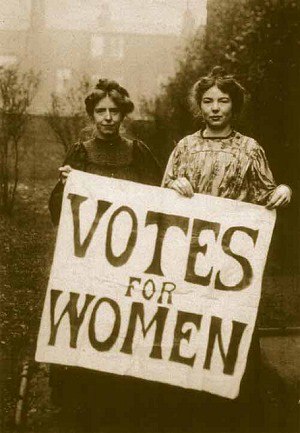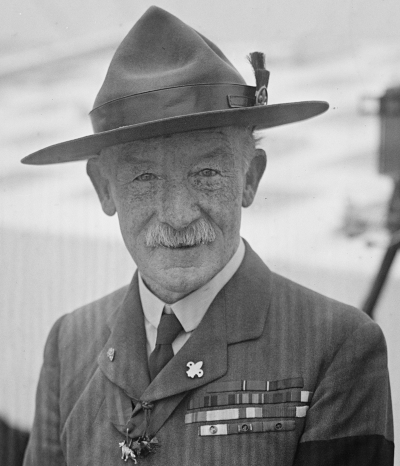Articles
- The 20th century
- Key events
- Making sense of the tangible world
- Health and Welfare
- Space exploration
- Scientific advancement: computers, technology & textiles
- Monarchy
- Democracy & social mobility
- Transport and leisure
- Colonialism & post-colonialism
- Sexuality, marriage, parenthood & divorce
- Income & consumerism
- Humans and the environment
- Educational context
- Mass culture & entertainment
- The world of work
- Making sense of the intangible world
Democracy & social mobility
The right to voteTrade unionsGrowthIndustrial action and union restrictionSocial mobilityThe effect of warEducationFashion and cultureUniformed organisations
The right to vote
 At the start of the twentieth century, most men over the age of 21 (but no women) had the right to vote. The cause of women’s suffrage was promoted by the Suffragette movement in the early years of the century, only to be halted by the onset of war. However, the right of political representation was gradually extended in the course of the twentieth century:
At the start of the twentieth century, most men over the age of 21 (but no women) had the right to vote. The cause of women’s suffrage was promoted by the Suffragette movement in the early years of the century, only to be halted by the onset of war. However, the right of political representation was gradually extended in the course of the twentieth century:- From 1918, in recognition of their contribution to the First World War, virtually all men over 21 and property-owning women over 30 could vote
- From 1928, women had equal voting rights with men
- In 1970, the voting age was reduced to 18.
Prior to these changes, politicians could afford to give less attention to the requirements of people who could not vote. Now, they had to be aware of the needs of a much wider range of people.
Trade unions
Growth
Trade unions developed in the nineteenth century to represent the interests of working-class people at a time when few of them had the right to vote. By the start of the twentieth century, they played an important role in the creation of the Labour Party. Their influence within the Labour party continued throughout the century.
Trade union membership and influence grew significantly in the years before the First World War and the growth continued during the war years.
Industrial action and union restriction
 In 1926, the trade union movement organised the first (and, to date, only) General Strike in British history. It failed in its aims and the government subsequently passed laws to restrict trade union powers.
In 1926, the trade union movement organised the first (and, to date, only) General Strike in British history. It failed in its aims and the government subsequently passed laws to restrict trade union powers.Trade union influence was limited by economic depression in the 1930s and the Second World War in the 1940s. But their influence revived in the period of growing prosperity between the 1950s and 1970s. This was a time of almost constant unrest between trade unions and employers.
In the 1980s, the Conservative government led by Margaret Thatcher passed laws to limit trade union powers, and those laws continue, little changed, to the present day.
Social mobility
At the start of the twentieth century, British people were very conscious of the social class to which they belonged, with different classes of people living largely separate lives. Nevertheless, the changes imposed by the effect s of the Industrial Revolution meant that new classes of people had been emerging:
- There was a new ‘upper class’ of people whose wealth depended, not on possessing land but on ownership of industrial businesses (often referred to as the ‘nouveau riche’)
- A middle class was developing, comprising people with professional, managerial and clerical skills to serve the needs of industry.
Although movement between social classes was rare there was greater flexibility than there had been a century earlier.
The effect of war
Social mobility grew significantly in the twentieth century, particularly helped by the democratising effect of mass involvement in two world wars. For the first time people from all social classes mixed and worked alongside each other in the war effort, broadening their understanding of how ‘the other half’ lived. There was a sense of communal sacrifice which overrode class considerations and lingered into the decades following each conflict.
Education
Another key factor enabling social mobility was the expansion of free education. Secondary education was made compulsory in 1918 and, over the next six decades, the school leaving age was raised from 14 to 15 and then 16.
In the years following the Second World War, university education expanded dramatically. At university, young people from a range of social backgrounds mixed together.
The effect of all these changes was that young people from modest backgrounds were able to gain qualifications which had been unavailable to their parents. With these qualifications, they could get higher-paid, more prestigious jobs than older members of their family ever had. They could live in more prosperous areas and mix with people from different social backgrounds.
Fashion and culture
At the start of the twentieth century, it was possible to deduce a person's social class from their clothing. Their places of entertainment were also quite distinct.
The twentieth century saw the growth of mass entertainment in the form of film, radio and television. More than ever before, people from different social backgrounds were consuming the same entertainment. Film and television helped to set trends in the world of fashion which were followed by people from all social backgrounds.
From the 1960s onwards, there was a growing rejection, throughout British society, of formality and tradition. Working-class culture was increasingly celebrated, rather than looked down on. By the end of the twentieth century, people from different social backgrounds were attending the same cultural events and wearing remarkably similar types of clothing.
Uniformed organisations
 The growth of the Boy Scout and Girl Guide movement was significant in weakening social barriers among younger people. The movement began in the opening decade of the twentieth century, open to all young people, irrespective of race, origin or creed. It catered for young people from the age of 8 to 18 plus. By the end of the twentieth century, it had a UK membership of roughly one million.
The growth of the Boy Scout and Girl Guide movement was significant in weakening social barriers among younger people. The movement began in the opening decade of the twentieth century, open to all young people, irrespective of race, origin or creed. It catered for young people from the age of 8 to 18 plus. By the end of the twentieth century, it had a UK membership of roughly one million.A term applied to British women activists campaigning for the right to vote.
World War I, also know as the First World War and the Great War, was a global conflict from 1914 – 1918, centred in Europe, involving all the world’s major economic powers in two opposing alliances.
A centre-left political party in the United Kingdom, founded in 1900.
A nine day strike in 1926 of workers in all major industries.
The global war which lasted from 1939 – 1945
A centre-right political party in the United Kingdom, founded in 1834.
The very rapid development of industry in Britain through the growing use of machines in the late 18th and early 19th century.
Recently Viewed
Scan and go

Scan on your mobile for direct link.